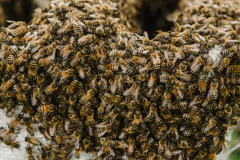Bee Swarms: Are they dangerous and what to do if you find one
When Do Honey Bees Swarm?
Honey bee swarming typically occurs in late spring and early summer, between March and May. Warming weather, nectar flow, and a wider array of nectar and pollen resources can contribute to the natural phenomenon. But what is happening within the hive that is at the root of a swarm is really interesting.
What Happens in a Hive During a Honey Bee Swarm?
Queen bees can use a natural pheromone to signal to the hive that she is ready to swarm or is nearing the end of her life. In either case, they will need a new queen. Select growing female larvae will then be fed a steady diet of royal jelly—a bee-made substance that’s rich in protein, various nutrients and trace minerals. The royal jelly will genetically alter the larvae, creating a new queen. Only one of these new queens will go on to reign over their hive.
Sometimes, when a hive becomes overcrowded, it’s possible that not every worker bee gets the message. If a new queen is born, the hive must split, because a healthy hive can have only one queen. So she and about 20,000 or so bees fill their stomachs and head out to find a new home.
Are Swarming Honey Bees Dangerous?
No, swarming honey bees are not dangerous. Because swarming bees are in a weakened state and are not defending a brood or food stores, they don’t pose much of a threat to people. They are more concerned with finding a new, permanent home and protecting the queen.
Contact Us for Cleveland Honey Bee Removal
That being said, honey bees will protect against aggression or provoking behavior, so it’s best to leave them alone and get in touch with a local beekeeper who can safely relocate the swarm. Contact Cleveland Bee Removal for a free estimate today!


